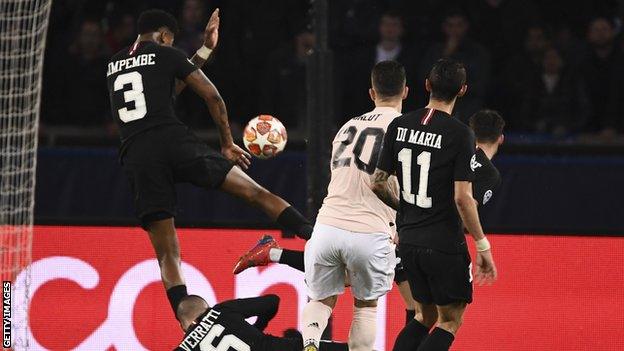PSG v Man Utd: The handball rule - what is the latest, and do you agree?
- Published
- comments

If a player's arms extend beyond a "natural silhouette", handball will be given, even if it is perceived as accidental, say the new handball rules
Manchester United's controversial injury-time penalty in their dramatic Champions League win over Paris St-Germain has got everyone talking about the handball rule and VAR.
Marcus Rashford thumped home the spot-kick in the 94th minute, awarded after referee Damir Skomina had initially signalled a corner after Diogo Dalot's shot struck Presnel Kimpembe and went over the crossbar.
Skomina received a signal to check the incident again for a possible handball in the box and after watching a pitchside monitor, changed his decision.
Injured PSG forward Neymar called the decision a "disgrace", asking "What can [Kimpembe] do with his hand while his back is turned?"
But what are the rules?
As it stands from the International Football Association Board (Ifab) rulebook:
Handling the ball involves a deliberate act of a player making contact with the ball with the hand or arm.
The following must be considered:
The movement of the hand towards the ball (not the ball towards the hand)
The distance between the opponent and the ball (unexpected ball)
The position of the hand does not necessarily mean that there is an offence
However, Head of Uefa referees Robert Rossetti told the Times, external in January that - when VAR was introduced into this season's Champions League - officials would penalise any unnatural arm movement that makes contact with the ball.
"The big challenge is the position of the arm. When the arm is totally out of the body above the shoulder it should be penalised. If the defender is making the body bigger in order to block the ball it is not fair.
"It is different if the defender is challenging or playing the ball and it rebounds. But if he is looking to block a cross or a shot on goal and the player is trying to spread his body then it is a handball."
What next?
At the weekend, Ifab - football's law-makers - said handball will be given against a player if their arms extend "beyond a natural silhouette" - even if it is accidental.
Ifab chief David Elleray explained: "If the arms are extended beyond that silhouette then the body is being made unnaturally bigger, with the purpose of it being a bigger barrier to the opponent or the ball.
"Players should be allowed to have their arms by their side because it's their natural silhouette."
That new interpretation will come in from 1 June - the date of the Champions League final.
